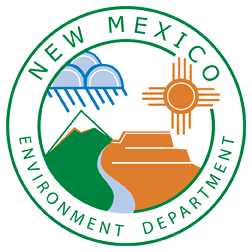Wetland Types in New Mexico
There are many different types of wetland ecosystems in New Mexico:
riverine – lacustrine – depressional – slope – mineral soil flats – organic soil flats
SWQB uses the Hydrogeomorphic (HGM) classification system developed by the US Army Corps of Engineers (US ACE) to define wetland areas. This system is based on three fundamental factors that influence how wetlands function. Download the USACE’s HGM report here.
Riverine Wetlands occur in floodplains and riparian corridors in association with stream channels. Dominant water sources are overbank flow from the channel or subsurface hydraulic connections between the stream channel and wetlands. Additional water sources may be interflow and return flow from adjacent uplands, occasional overland flow from adjacent uplands, tributary inflow, and precipitation.
Lacustrine Fringe Wetlands are adjacent to lakes where the water elevation of the lake maintains the water table in the wetland. Additional sources of water are precipitation and groundwater discharge. Surface water flow is bidirectional, usually controlled by water level fluctuations in the adjoining lake. Lacustrine wetlands lose water by flow returning to the lake after flooding, by saturation surface flow, and by evapotranspiration.
Depressional Wetlands occur in topographic depressions with a closed elevation contour that allows accumulation of surface water. Dominant sources of water are precipitation, groundwater discharge, and interflow from adjacent uplands. Water normally flows from the surrounding uplands toward the center of the depression. Depressional wetlands may have any combination of inlets and outlets or lack them completely. Depressional wetlands may lose water through intermittent or perennial drainage from an outlet, by evapotranspiration, and, if they are not receiving groundwater discharge, may slowly contribute to groundwater. Water levels will most often vary seasonally. Prairie potholes are a common example of depressional wetlands. Playas of the Llano Estacado are also considered depressional wetlands.
Slope Wetlands are normally found where there is a discharge of groundwater to the land surface. Elevation gradients may range from steep hillsides to gentle slopes. Principal water sources are usually groundwater return flow, interflow from surrounding uplands, and precipitation. Slope wetlands can occur in nearly flat landscapes if groundwater discharge is a dominant water source. They loose water primarily by saturation subsurface and surface flows and by evaporation. Springs are an example of slope wetlands in New Mexico.
Mineral Soil Flats are most common on interfluves, extensive relic lake bottoms, or large floodplain terraces where the main source of water is precipitation. They receive virtually no groundwater discharge which distinguishes them from depressions and slopes. They lose water by evapotranspiration, saturation overland flow, and seepage to underlying groundwater. They are distinguished from flat upland areas by their poor vertical drainage. Mineral soil flats that accumulate peat can eventually become the class organic soil flats. The Lordsburg Playa is an example of a mineral soil flat wetland.
For more information:

